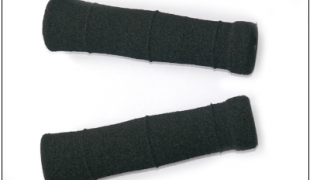- 5075
- 341
- 10
- 9
- 0
- Help Ukraine
About the solution
Stephen and Elizabeth suffer from disabilities and they also teach disabilities studies at the University of Maine. In 2008, Elizabeth was training for a triathlon but, while training, she realised her terrible balance would prevent her from participating.
“We looked around for a device, and we could only find stigmatized, ugly devices,” Elizabeth said. “Stephen’s background is in art. I said, ‘Let’s invent something that looks good and that functions, too.’”
Stephen, Elizabeth and Vince, a friend and mechanical engineer, they came up with a prototype for the mobility device called Afari.
Afari is a three-wheeled device that allows users to stand up straight as they walk or run with the balance and stability support they need. Afari has breaks and active steering.
“We wanted a design that would be functional, that somebody would be proud to use in public,” Stephen said.
“People are stooped over. You feel sorry for them. They look debilitated,” Elizabeth said. “My dad, who is 93, uses a wheeled walker. He doesn’t want to go out in it. It’s embarrassing. Whereas, if you see the Afari, people walk over and say, ‘Wow, isn’t that cool.’ You stand up straight. You look them in the eye. It’s functional — you can go anywhere.”
Afari has been through seven design cycles and became the flagship for Mobility Tech, a company started as a partnership with the University of Maine. “We’ve got people with brain tumors that are running again. I honestly didn’t expect the overwhelming positive response. Now people can go outside their homes without being afraid of falling. It’s more than physical health. The social aspect is amazing, too,” Ryan Beaumont, CEO of the company said.
Adapted from: https://bangordailynews.com/2019/09/29/news/midcoast/they-couldnt-find-a...
This solution shall not include mention to the use of drugs, chemicals or biologicals (including food); invasive devices; offensive, commercial or inherently dangerous content. This solution was not medically validated. Proceed with caution! If you have any doubts, please consult with a health professional.
DISCLAIMER: This story was written by someone who is not the author of the solution, therefore please be advised that, although it was written with the utmost respect for the innovation and the innovator, there can be some incorrect statements. If you find any errors please contact the patient Innovation team via info@patient-innovation.com
-
-
354
-
0
-
3867

Woman creates walker stabilizer for her grandfather
WALKING: Walking
WALKING WITH A WALKING AID: Walking with a walking aid
Parkinson's Disease
Arthritis
Muscle Tone Abnormalities weakness
Walking Aid (wheelchair/walker/crutches)
Assistive Daily Life Device (to help ADL)
Difficulty walking or moving
Gait abnormalities (e.g., walking difficulties, unsteady gait)
Muscle weakness
Tremors
Muscle cramps or spasms
Difficulty coordinating movements
Stiffness or rigidity (difficulty moving)
Limited range of motion
Muscle pain or stiffness
Loss of balance
Loss of muscle coordination
Joint deformity
Swelling or inflammation
Frequent falls
Joint pain or swelling
Maintaining Balance and Mobility
Caregiving Support
Neurology
Orthopedics
Rheumatology
United States
-
-
-
596
-
0
-
9651

Chic – Aid - Strlish crutches
WALKING WITH A WALKING AID: Walking with a walking aid
Multiple Sclerosis
Demyelination
Spinal Cord and Nerve Root Disorders
Walking Aid (wheelchair/walker/crutches)
Assistive Daily Life Device (to help ADL)
Gait abnormalities (e.g., walking difficulties, unsteady gait)
Muscle cramps or spasms
Difficulty coordinating movements
Stiffness or rigidity (difficulty moving)
Muscle weakness
Numbness or tingling in the extremities
Maintaining Balance and Mobility
Preventing (Vaccination, Protection, Falls, Research/Mapping)
General and Family Medicine
Neurology
Orthopedics
United Kingdom
-
-
-
353
-
0
-
3771

Hip & co- a mum's invention for hip dysplasia
CAREGIVING
BODY BALANCE: Maintaining body balance
STANDING UP: Standing up from a seated position
WALKING WITH A WALKING AID: Walking with a walking aid
WALKING: Walking
Hip Dysplasia
Assistive Daily Life Device (to help ADL)
Walking Aid (wheelchair/walker/crutches)
Difficulty walking or moving
Muscle weakness
Limited range of motion
Muscle pain or stiffness
Loss of muscle coordination
Muscle cramps or spasms
Joint deformity
Joint redness or warmth
Swelling or inflammation
Difficulty bearing weight
Numbness or tingling in the extremities
Frequent falls
Joint pain or swelling
Restoring mobility
Managing pain
Promoting self-management
Preserving Organ Function
Recovering from Traumatic Injuries
Maintaining Balance and Mobility
Raise awareness
Caregiving Support
General and Family Medicine
Orthopedics
Pediatrics
Australia
-
 en
en